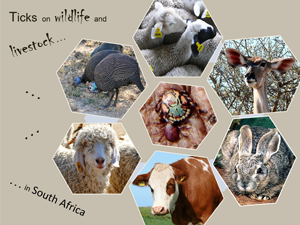Published online by Cambridge University Press: 04 February 2022

South Africa has a diverse fauna of ixodid tick species, several of which are of medical or veterinary importance. Elucidation of which host or environmental characteristics determine the composition and abundance of tick assemblages is, therefore, highly relevant to disease management and wildlife conservation efforts. Here, we analysed the similarity in ixodid tick assemblages of three wildlife and three livestock species in a natural (Great Fish River Reserve) and anthropogenic (an adjacent farm) habitat in South Africa. We compared tick infracommunities of three wild host species between the reserve and the farm; of three wild host species within the reserve and of wild and livestock species on the farm (considering body size). Hosts examined in this study harboured the adults and immature stages of 11 tick species belonging to five ixodid genera. Notably, several tick species of South African wildlife have successfully made the switch to livestock and thus both wild hosts and livestock now contribute to the pool of maintenance hosts for these ticks as well as their associated pathogens. This is an important consideration when translocating wildlife or livestock as part of farming or conservation activities.